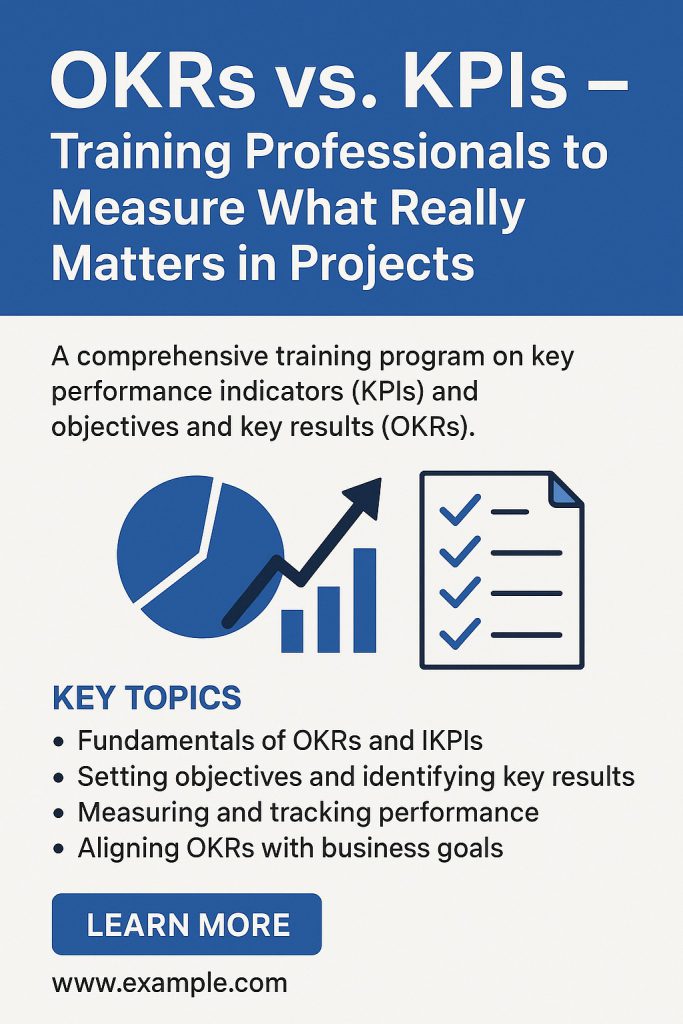In today’s fast-paced, outcome-driven world of project management, professionals are under constant pressure to prove the value of their work. Beyond completing tasks on time and within budget, organizations increasingly want evidence of measurable impact. That’s where frameworks like Objectives and Key Results (OKRs) and Key Performance Indicators (KPIs) come in.
Both terms get thrown around frequently in boardrooms, training sessions, and project updates—but what do they really mean, and how do they differ? More importantly, which framework should professionals use to measure project performance and success?
This blog post unpacks the distinction between OKRs and KPIs, highlights their unique value, and explains why training professionals to understand both is critical for modern project environments.
Understanding OKRs: Driving Alignment and Outcomes
OKRs (Objectives and Key Results) originated at Intel in the 1970s and have since been popularized by tech giants like Google. Their core purpose is to help teams focus on ambitious, outcome-oriented goals that align with the organization’s larger vision.
Objectives: These are qualitative, inspiring, and ambitious goals. For example: “Deliver a best-in-class digital training experience.”
Key Results: These are measurable, time-bound outcomes that prove whether the objective has been achieved. For example: “Achieve a 95% learner satisfaction rate within the next quarter.”
The strength of OKRs lies in their ability to encourage forward-thinking and innovation. They challenge teams to stretch beyond “business as usual” and measure progress not only by effort but by actual impact. For project professionals, this means OKRs serve as a compass, helping them connect their day-to-day activities to long-term business outcomes.
Understanding KPIs: Measuring Performance and Stability
KPIs (Key Performance Indicators), on the other hand, are metrics used to evaluate the success of ongoing activities or projects. Unlike OKRs, which set ambitious targets, KPIs are more about tracking performance against predefined standards.
Examples include:
Project completion rate
Budget variance
Number of defects identified during quality checks
Employee productivity scores
KPIs are essential because they provide a snapshot of efficiency and consistency. For organizations, they serve as guardrails, ensuring that processes remain stable, predictable, and within acceptable thresholds. For project managers, KPIs are especially valuable for monitoring project health, identifying risks early, and reporting progress to stakeholders.
OKRs vs. KPIs: Complementary, Not Competitive
It’s tempting to ask, “Which is better—OKRs or KPIs?” But the reality is that they serve different purposes and work best when combined.
OKRs push teams to aim higher and innovate. They help ensure that projects deliver meaningful outcomes tied to strategy.
KPIs provide the operational data needed to manage performance and ensure stability. They highlight whether processes are efficient and sustainable.
For example, a project team might have an OKR to “Revolutionize customer experience in online training” with a Key Result of achieving “80% course completion rate within three months.” At the same time, their KPIs might track learner drop-off rate per module or average time spent on the platform.
Together, OKRs set the vision, while KPIs ensure that the work is efficient and measurable along the way.
Why Training Professionals Must Master Both
In project environments—whether Agile, traditional, or hybrid—understanding OKRs and KPIs is no longer optional. Professionals must learn how to:
Set meaningful objectives that link project deliverables to organizational strategy.
Identify and track KPIs that provide real-time insights into performance and quality.
Balance ambition with accountability by combining visionary OKRs with operational KPIs.
Communicate results effectively to stakeholders, bridging the gap between what was promised and what was delivered.
Training programs that incorporate both OKRs and KPIs help professionals shift from simply “managing tasks” to delivering value and outcomes. It’s not just about doing things right—it’s about doing the right things and measuring them in a way that stakeholders care about.
The Future of Measuring What Matters
As organizations embrace Agile project management, digital transformation, and real-time analytics, the role of metrics is evolving. Leaders are no longer satisfied with metrics that show activity—they want proof of outcomes. That’s why OKRs are gaining momentum in Agile environments. Yet, KPIs remain indispensable for operational stability.
For modern project professionals, learning how to use both frameworks effectively is what separates good managers from strategic leaders. The ability to align project work with strategic objectives (via OKRs) and monitor execution efficiency (via KPIs) ensures relevance in an increasingly competitive market.
Final Thoughts
So, are OKRs replacing KPIs? The answer is no—they are partners, not rivals. The real skill lies in knowing when and how to apply each. By mastering both, project professionals can deliver not just completed projects, but meaningful outcomes that drive business growth.
Call to Action
Ready to take your skills to the next level?
Enroll today and transform your career with ScrumConsult’s professional training programs. From Scrum Master Certification in Lagos to Agile Expert, Project Management, Business Analysis, Lean Six-Sigma Green & Black Belt, SMC, PSM, and CSM, we provide the tools and knowledge you need to thrive in a data-driven world.
📌 Visit scrumconsult.com
today to get started.

